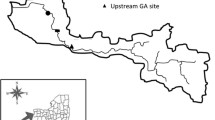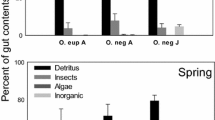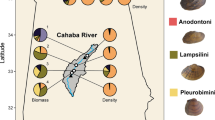Abstract
The effects of invasive species on native communities often depend on the characteristics of the recipient community and on the food habits of the invasive species, becoming complicated when the invader is omnivorous. In field enclosure experiments, we assessed the direct and interactive effects of an invasive omnivorous crayfish (Procambarus clarkii) and either native herbivorous snails (Physella gyrina) or shrimp (Atyoida bisulcata) on stream communities in California and Hawaii, respectively. Based on literature data and the characteristics of each study site, we predicted that crayfish would affect primarily algal-based trophic linkages in an open California stream but detritus-based trophic linkages in a shaded Hawaiian stream, with trophic cascades mediated through crayfish effects on primary consumers being observed in both systems. As predicted, crayfish in California directly reduced periphyton, filamentous algae, sediment, and snail levels, but generated a cascade by decreasing snail densities and increasing periphyton biomass. Contrary to prediction, crayfish did not reduce total invertebrate biomass. As predicted, crayfish in Hawaii reduced leaf litter, filamentous algae, and benthic invertebrate biomass. Contrary to our predictions, however, a trophic cascade was not observed because shrimp did not affect periphyton levels, crayfish did not reduce shrimp abundance, and crayfish had greater negative impacts on filamentous algae than did shrimp. Our findings highlight that the same invasive species can generate different effects on disparate systems, probably as mediated through the availability of different food types, flexibility in the invasive species’ food habits, and complex pathways of trophic interaction.






Similar content being viewed by others
References
Banha F, Anastácio PM (2011) Interactions between invasive crayfish and native river shrimp. Knowl Manag Aquatic Ecosyst 17:1–12
Creed RP (1994) Direct and indirect effects of crayfish grazing in a stream community. Ecology 75:2091–2103
Creed RP, Reed JM (2004) Ecosystem engineering by crayfish in a headwater stream community. J North Am Benthol Soc 23:224–236
Dillon RT Jr, Wethington AR (2004) No-choice mating experiments among six nominal taxa of the subgenus Physella (Basommatophora: Physidae). Heldia 6:69–78
Dorn NJ, Wojdak JM (2004) The role of omnivorous crayfish in littoral communities. Oecologia 140:150–159
Dudgeon D, Arthington AH, Gessner MO, Kawabata Z, Knowler DJ, Leveque C, Naiman RJ, Prieur-Richard A, Soto D, Stiassny MLJ, Sullivan CA (2006) Freshwater biodiversity: importance, threats, status and conservation challenges. Biol Rev 81:163–182
Elton CS (1958) The ecology of invasions by animals and plants. Methuen, London
Englund G, Cooper SD, Sarnelle O (2001) Application of a model of scale dependence to quantify scale domains in open predation experiments. Oikos 92:501–514
Fridley JD, Stachowicz JJ, Naeem S, Sax DF, Seabloom EW, Smith MD, Stohlgren TJ, Tilman D, Von Holle B (2007) The invasion paradox: reconciling pattern and process in species invasions. Ecology 88:3–17
Gamradt SC, Katz LB (1996) Effect of introduced crayfish and mosquitofish on California newts. Conserv Biol 10:1155–1162
Guan R, Wiles RP (1997) Ecological impact of introduced crayfish on benthic fishes in a British lowland river. Conserv Biol 11:641–647
Gulis V, Suberkropp K (2003) Leaf litter decomposition and microbial activity in nutrient-enriched and unaltered reaches of a headwater stream. Freshw Biol 48:123–134
Hart DD (1992) Community organization in streams: the importance of species interactions, physical factors, and chance. Oecologia 91:220–228
Herbold B, Moyle PB (1986) Introduced species and vacant niches. Am Nat 128:751–760
Hobbs RJ, Huenneke LF (1992) Disturbance, diversity and invasion: implications for conservation. Conserv Biol 6:324–337
Holmes SJ (1924) The genus Cambarus in California. Science 60:358–359
Holway DA, Suarez AV, Case TJ (2002) Role of abiotic factors in governing susceptibility to invasion: a test with Argentine ants. Ecology 83:1610–1619
Huner JV (1977) Introductions of the Louisiana red swamp crayfish, Procambarus clarkii (Girard): an update. Freshw Cray 3:193–202
Huner JV (2002) Background and functional morphology. In: Holdich DM (ed) Biology of freshwater crayfish. Blackwell, Cornwall, pp 541–584
Ilheu M, Bernardo JM (1993) Experimental evaluation of food preferences of red swamp crayfish (Procambarus clarkii): vegetal vs. animal. Freshw Cray 9:359–364
James MR, Hawes I, Weatherhead M (2000) Removal of settled sediments and periphyton from macrophytes by grazing invertebrates in the littoral zone of a large oligotrophic lake. Freshw Biol 44:311–326
Klose K (2007) Complex effects of an invasive consumer (Procambarus clarkii) on stream communities in southern California and Hawaii. PhD dissertation, University of California, Santa Barbara
Klose K (2011) Snail responses to cues produced by an invasive decapod predator. Invertebr Biol 130:226–235
Klose K, Cooper SD (2012) Contrasting effects of an invasive crayfish (Procambarus clarkii) on two temperate stream communities. Freshw Biol 57:526–540
Kolar CS, Lodge DM (2000) Freshwater nonindigenous species: interactions with other global changes. In: Mooney HA, Hobbs RJ (eds) Invasive species in a changing world. Island Press, Washington DC, pp 3–30
Kolar CS, Lodge DM (2001) Progress in invasion biology: predicting invaders. Trends Ecol Evol 16:199–204
Larned ST, Kinzie RA, Covich AP, Chong CT (2003) Detritus processing by endemic and non-native Hawaiian stream invertebrates: a microcosm study of species-specific effects. Arch Hydrobiol 156:241–254
Levine JM, D’Antonio CM (1999) Elton revisited: a review of evidence linking diversity and invasibility. Oikos 87:15–26
Lodge DM, Kershner MW, Aloi JE, Covich AP (1994) Effects of an omnivorous crayfish (Orconectes rusticus) on a freshwater littoral food web. Ecology 75:1265–1281
Luttenton MR, Horgan MJ, Lodge DM (1998) Effects of three Orconectes crayfishes on epilithic microalgae: a laboratory experiment. Crustaceana 71:845–855
March JG, Pringle CM, Townsend MJ, Wilson AI (2002) Effects of freshwater shrimp assemblages on benthic communities along an altitudinal gradient of a tropical island stream. Freshw Biol 47:377–390
Matsuzaki SS, Usio N, Takamura N, Washitani I (2009) Contrasting impacts of invasive engineers on freshwater ecosystems; an experiment and meta-analysis. Oecologia 158:673–686
McCarthy JM, Hein CL, Olden JD, Vander Zanden MJ (2006) Coupling long-term studies with meta-analysis to investigate impacts of non-native crayfish on zoobenthic communities. Freshw Biol 51:224–235
Mermillod-Blondin F, Gaudet JP, Gerino M, Desrosiers G, Jose J, Creuzé des Châtelliers M (2004) Relative influence of bioturbation and predation on organic matter processing in river sediments: a microcosm experiment. Freshw Biol 49:895–912
Merritt RW, Cummins KW (1996) An introduction to the aquatic insects of North America, 3rd edn. Kendall/Hunt, Dubuque
Meyer E (1989) The relationship between body length parameters and dry mass in running water invertebrates. Arch Hydrobiol 117:191–203
Naeem S, Knops JMH, Tilman D, Howe KM, Kennedy T, Gale S (2000) Plant diversity increases resistance to invasion in the absence of covarying extrinsic factors. Oikos 91:97–108
Nichols FH, Thompson JK, Schemel LE (1990) Remarkable invasion of San Francisco Bay (California, USA) by the Asian clam Potamocorbula amurensis. II. Displacement of a former community. Mar Ecol Prog Ser 66:95–101
Nilsson E, Olsson K, Persson A, Nyström P, Svensson G, Nilsson U (2008) Effects of stream predator richness on the prey community and ecosystem attributes. Oecologia 157:641–651
Nyström P (2005) Non-lethal predator effects on the performance of a native and an exotic crayfish species. Freshw Biol 50:1938–1949
Nyström P, Brönmark C, Graneli W (1999) Influence of an exotic and a native crayfish species on a littoral benthic community. Oikos 85:545–553
Parkyn SM, Rabeni CF, Collier KJ (1997) Effects of crayfish (Paranephrops planifrons: Parastacidae) on in-stream processes and benthic faunas: a density manipulation experiment. NZ J Mar Freshw Res 31:685–692
Parkyn SM, Collier KJ, Hicks BJ (2001) New Zealand crayfish: functional omnivores but trophic predators? Freshw Biol 46:641–652
Polis GA, Sears ALW, Huxel GR, Strong DR, Maron J (2000) When is a trophic cascade a trophic cascade? Trends Ecol Evol 15:473–475
Pringle CM, Blake GA, Covich AP, Buzby KM, Finley A (1993) Effects of omnivorous shrimp in a montane tropical stream: sediment removal, disturbance of sessile invertebrates and enhancement of understory algal biomass. Oecologia 93:1–11
Quinn GP, Keough MJ (2002) Experimental design and data analysis for biologist, 1st edn. Cambridge University Press, Cambridge
Resh VH, Barnes JR, Craig DA (1990) Distribution and ecology of benthic macroinvertebrates in the Opunohu river catchment, Moorea, French Polynesia. Ann Limnol 26:195–214
Ricciardi A, Rasmussen JB (1999) Extinction rates of North American freshwater fauna. Conserv Biol 13:1220–1222
Ricker WE (1975) Computation and interpretation of biological statistics of fish populations. Bull Fish Res Bd Can 191, Ottawa
Riegel JA (1959) The systematics and distribution of the crayfishes in California. Calif Fish Game 45:29–50
Riley SPD, Busteed GT, Kats LB, Vandergon TL, Lee LFS, Dagit RG, Kerby JL, Fisher RN, Sauvajot RM (2005) Effects of urbanization on the distribution and abundance of amphibians and invasive species in southern California streams. Conserv Biol 19:1894–1907
Sala OE, Chapin FS III, Armesto JJ, Berlow E, Bloomfield J, Dirzo R, Huber-Sanwald E, Huenneke LF, Jackson RB, Kinzig A, Leemans R, Lodge DM, Mooney HA, Oesterheld M, Poff NL, Sykes MT, Walker BH, Walker M, Wall DH (2000) Global biodiversity scenarios for the year 2100. Science 287:1770–1774
Sarnelle O, Kratz KW, Cooper SD (1993) Effects of an invertebrate grazer on the spatial arrangement of a benthic microhabitat. Oecologia 96:208–218
Sartory DP, Grobbelaar JU (1986) Extraction of chlorophyll a from freshwater phytoplankton for spectrophotometric analysis. Hydrobiologia 114:177–188
Schofield KA, Pringle CM, Meyer JL, Sutherland AB (2001) The importance of crayfish in the breakdown of rhododendron leaf litter. Freshw Biol 46:1191–1204
Schofield KA, Pringle CM, Meyer JL, Rosi-Marshall EJ (2008) Functional redundancy of stream macroconsumers despite differences in catchment land use. Freshw Biol 53:2587–2599
Sheldon SP (1987) The effects of herbivorous snails on submerged communities in Minnesota lakes. Ecology 71:1215–1216
Steinman AD, Lamberti GA (1996) Biomass and pigments of benthic algae, chapter 14. In: Hauer F, Lamberti G (eds) Methods in stream ecology. Academic, San Diego, pp 295–313
Stenroth P, Nyström P (2003) Exotic crayfish in a brown water stream: effects on juvenile trout, invertebrates and algae. Freshw Biol 48:466–475
Stohlgren TJ, Binkley D, Chong GW, Kalkhan MA, Schell LD, Bull KA, Otsuki Y, Newman G, Bashkin M, Son Y (1999) Exotic plant species invade hot spots of native plant diversity. Ecology 69:25–46
Thompson RM, Hemberg M, Starzomski BM, Shurin JB (2007) Trophic levels and trophic tangles: the prevalence of omnivory in real food webs. Ecology 88:612–617
Thorpe JH, Covich AP (2001) Ecology and classification of North American freshwater invertebrates, 2nd edn. Academic, San Diego
Turner AM, Bernot RJ, Boes CM (2000) Chemical cues modify species interactions: the ecological consequences of predator avoidance by freshwater snails. Oikos 88:148–158
Usio N (2000) Effects of crayfish on leaf processing and invertebrate colonization of leaves in a headwater stream: decoupling of a trophic cascade. Oecologia 124:608–614
Usio N, Townsend CR (2004) Roles of crayfish: consequences of predation and bioturbation for stream invertebrates. Ecology 85:807–822
Vandermeer J (2006) Omnivory and the stability of food webs. J Theor Biol 238:497–504
Vitousek PM, Walker LR (1989) Biological invasions by Myrica faya in Hawaii: plant demography, nitrogen fixation, ecosystem effects. Ecol Monogr 59:247–265
Zhang Y, Richardson JS, Negishi JN (2004) Detritus processing, ecosystem engineering and benthic diversity: a test of predator-omnivore interference. J Anim Ecol 73:756–766
Ziegler AC (2002) Hawaiian natural history, ecology, and evolution, 1st edn. University of Hawai’i Press, Honolulu
Acknowledgments
We thank A. Alker, S. Asao, T. Even, D. Johnson, J. Jones, N. Lackey-Shaffer, H. Le, C. Nelson, C. Osovitz, L. Resovsky, B. Rowan, J. Serb, K. Taulbee, C. Tillman, M. Watts, J. Wiklund and S. Wiseman for laboratory and field assistance. We also thank A. Alldredge, S. Holbrook, B. Downes, and three anonymous reviewers for helpful comments that improved the quality of this manuscript. We are grateful to R. Sheets of the Ojai Sanitation District for permission to work at the Ventura River site and his generous hospitality. This research was supported by funds from a Santa Barbara Coastal Long Term Ecological Research Grant (NSF OCE99-82105), a Graduate Opportunity Fellowship, and Science and Engineering Research Grant from the University of California. The senior author would like to dedicate this paper, which is the result of our shared field efforts, to the memory of Charles T. Chong. Charlie’s profound knowledge of Hawaiian streams inspired this work, and my memories of his friendship, dedication, and devotion to his homeland brought it to completion. Aloha.
Author information
Authors and Affiliations
Corresponding author
Additional information
Communicated by Barbara Downes.
Electronic supplementary material
Below is the link to the electronic supplementary material.
Rights and permissions
About this article
Cite this article
Klose, K., Cooper, S.D. Complex impacts of an invasive omnivore and native consumers on stream communities in California and Hawaii. Oecologia 171, 945–960 (2013). https://doi.org/10.1007/s00442-012-2449-y
Received:
Accepted:
Published:
Issue Date:
DOI: https://doi.org/10.1007/s00442-012-2449-y




